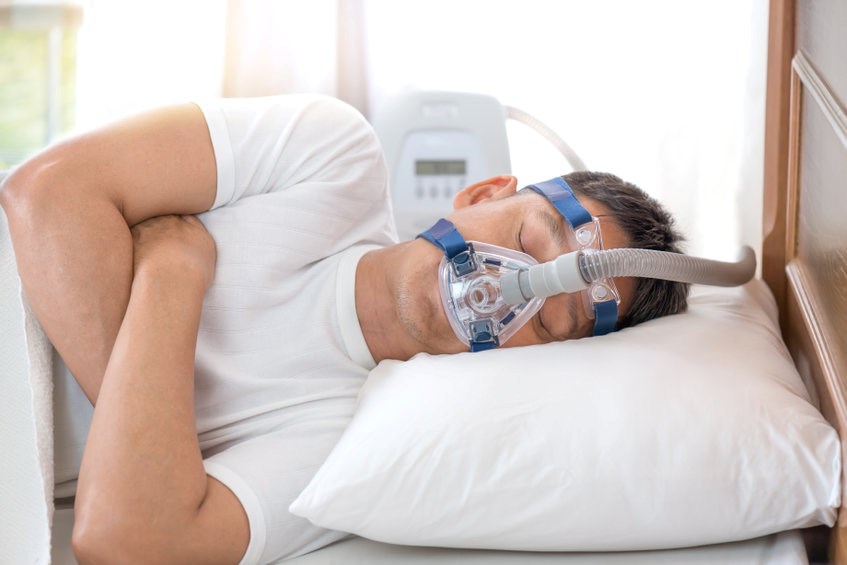Diagnosed with sleep apnea? What’s next?
Have you recently been diagnosed with a type of sleep apnea? Whether you were diagnosed with obstructive sleep apnea, central sleep apnea, or a combination of the two, it is difficult to know what to do next. Here are some steps you may take after you’ve been diagnosed:

1. Review test results:
Following your diagnosis, your doctor should go over your test results with you and suggest different treatments based on the type and severity of your sleep apnea. A doctor may recommend lifestyle changes and/or therapy to improve your sleep apnea symptoms. In more severe cases, surgery may be necessary.
2. Make lifestyle changes:
If you have mild sleep apnea, you may be able to improve your symptoms with several key lifestyle changes:
- Lose weight — This can relieve constriction of your throat and clear your airway.
- Exercise daily — 30 minutes of moderate daily exercise (such as a brisk walk) can improve symptoms even without weight loss.
- Avoid alcohol, tranquilizers, & sleeping pills — All of these things relax the muscles in the back of your throat and interfere with breathing.
- Sleep on your side or abdomen — If you sleep on your back, your tongue and soft palate may rest against the back of your throat, blocking your airway.
- Seek treatment for nasal allergies — Nasal allergies can contribute to the blockage of your airway.
- Refrain from smoking — Those who smoke can experience worsened symptoms.
3. Try therapy:
If the lifestyle changes you’ve made have not improved your symptoms, your doctor may point you toward a sort of sleep apnea therapy. When undergoing therapies, you may visit a sleep center regularly to monitor your therapy requirements and effectiveness.
- CPAP — This device delivers constant, gentle airflow through a mask while you sleep to keep your airway open and prevent apnea and snoring. CPAP is the most common and most reliable form of treatment, and there are things you can do to maximize mask comfortability.
- BiPAP/VPAP — If your sleep apnea is not improved with CPAP, your doctor may suggest this device that will provide more air pressure when you inhale and less pressure when you exhale.
- APAP — Instead of a BiPAP/VPAP, your doctor may recommend this device that can automatically adjust your pressure according to your needs while you sleep.
- Oral Appliances — These devices keep your throat open and can relieve snoring and mild obstructive sleep apnea. Although these devices are not as reliably effective as CPAP, they may be easier to use.
- Treatment for connected medical problems — If your sleep apnea is a result of a heart or neuromuscular disorder, treatment of those disorders could improve your sleep apnea.
- Supplemental Oxygen — If you have central sleep apnea, your doctor may suggest a device that delivers a certain type of oxygen to your lungs.
- Adaptive Servo-Ventilation (ASV) — This recently approved airflow device records your normal breathing pattern and uses the recorded information to determine the airflow. This device may not be a good fit for those with predominant central sleep apnea and advanced heart failure.
4. Have surgery (if absolutely necessary):
If your attempts to treat your sleep apnea have failed, your doctor may suggest surgery. However, if your sleep apnea is related to particular jaw structure issues, surgery may be a good first option.
- Tissue Removal — Doctors can remove tissue from the back of your mouth and top of your throat to prevent snoring. This surgery is less reliably effective than CPAP.
- Tissue Shrinkage — If you have mild-to-moderate sleep apnea, your doctor may shrink the tissue blocking your airway using radiofrequency ablation.
- Jaw Repositioning — If your jaw structure is causing your sleep apnea, your doctor can move your jaw forward from your other face bones to create more space behind your tongue and soft palate and prevent airway blockage.
- Tracheostomy — If other treatment options fail and you have severe, life-threatening sleep apnea, your doctor may need to create a new airway through a tube in your neck.
More research needs to be done to determine whether soft-rod implant surgery and nerve stimulation surgery are plausible options to keep your airway open at night.
5. Comply with treatment:
Many people with sleep apnea find it most difficult to continually comply with their therapy requirements. However, consistent therapy is the best way to improve your sleep apnea symptoms.
Sleep apnea treatment machines are available online. Home Medical Equipment Locations offers a reliable way to buy CPAP supplies, masks, and machinery and an easy way to find sleep centers.
